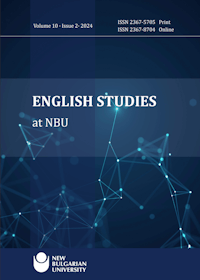Children as Commodities in the American Suburban Home: Joyce Carol Oates’s Adaptation of the Ramsey Case in "My Sister, My Love"
DOI:
https://doi.org/10.33919/esnbu.24.2.2Keywords:
Joyce Carol Oates, children exploitation, Ramsey Case, American suburbsAbstract
Joyce Carol Oates's My Sister, My Love is a fictional memoir inspired by the unsolved murder of JonBenét Ramsey. The novel, told from the perspective of the victim's brother, satirizes the exploitation of children in beauty pageants and the superficiality of suburban life. Through a counter-memory narrative, Oates sheds light on the hidden abuse endured by children, revealing the dark underbelly of a seemingly perfect family. The novel serves as a powerful critique of societal pressures and the devastating consequences for young victims.
References
Alexander, C., & McMaster, J. (2005). The Child Writer from Austen to Woolf. Cambridge University Press.
Allen, M. (1976). The Necessary Blankness, Women in Major Fiction of the Sixties. University Press of Illinois.
Arcana, J. (1979). Our Mother’s Daughters. Shameless Hussy Press.
Bakhtin, M. (1981). The Dialogic Imagination. Texas University Press.
Blaffer Hrdy, S. (1999). Mother Nature: History of Mothers, Infants, and Natural Selection. Pantheon Books.
Douglas, J. E., Olshaker, M. (2000). The Cases that Haunt Us. Scribner.
Farnham, M., & Lundberg, F. (1947). Modern Woman: The Lost Sex. Harper & Brothers Publishers.
Foley, D. (2011, September 27). Joyce Carol Oates on her Fictional Version of the JonBenet Ramsey Murder. Newark Star-Ledger. http://dylanmfoley.blogspot.com/2011/09/joyce-carol-oates-on-her-fictional.html
Hodges, A. G. (1998). A Mother Gone Bad: The Hidden Confession of JonBenét’s Killer. Village House.
Johnson, G. (1998). Joyce Carol Oates: Invisible Writer. Plume.
Katz, C. (2011). Accumulation, Excess, Childhood: Toward a Countertopography of Risk and Waste. Documents d’Analisi Geografica, 57(1), 47-60. https://doi.org/10.5565/rev/dag.806
Katz, C. (2012). Just Managing: American Middle-Class Parenthood in Insecure Times. In R. Heiman, C. Freeman, & M. Liechty (Eds.), The Global Middle Classes: Theorizing through Ethnography (pp. 169-188). SAR Press.
Klein, M. (1998). Love, Guilt and Reparation and Other Works 1921-1945. Vintage.
Lipsitz, G. (2001). Time Passages: Collective Memory and American Popular Culture. University of Minnesota Press.
Oates, J. C. (1999, June 24). The Mystery of JonBenét Ramsey. New York Review of Books. https://www.nybooks.com/articles/1999/06/24/the-mystery-of-jonbenet-ramsey
Oates, J. C. (2008). My Sister, My Love. Harper Collins.
Parker, R. (1995). Mother Love/Mother Hate: The Power of Maternal Ambivalence. Basic Books.
Pickering, S. J. (1974). The Short Stories of Joyce Carol Oates. Georgia Review, 28(2), 218-226.
Ramsey, J., & Ramsey, P. (2001). The Death of Innocence. Onyx.
Ricoeur, P. (1985). Time and Narrative. University Press of Chicago.
Schiller, L. (1999). Perfect Murder, Perfect Town: JonBenét and the City of Boulder. Harper Collins.
Shields, D. (2010). Reality Hunger. A Manifesto. A. Knopf. https://doi.org/10.1353/wlt.2010.0041
Smith, C. (1999). Death of a Little Princess: The Tragic Story of the Murder of JonBenét Ramsey. St. Martin’s Press.
Thomas, S. (2000). JonBenét: Inside the Ramsey Murder Investigation. St. Martin’s Press.
Yagoda, B. (2009). Memoir, a History. Riverhead Books.
Zaretsky, N. (2007). No Direction Home: The American Family and the Fear of National Decline 1968-1980. Chapel Hill: University Press of North Carolina. https://doi.org/10.5149/9780807867808_zaretsky
Downloads
Published
How to Cite
Issue
Section
License
Copyright (c) 2025 Barbara Miceli

This work is licensed under a Creative Commons Attribution-NonCommercial 4.0 International License.
All published articles in the ESNBU are licensed under the Creative Commons Attribution-NonCommercial 4.0 International License (CC BY-NC 4.0). This license lets others remix, tweak, and build upon your work non-commercially, and although their new works must also acknowledge you and be non-commercial, they don't have to license their derivative works on the same terms.
In other words, under the CC BY-NC 4.0 license users are free to:
Share - copy and redistribute the material in any medium or format
Adapt - remix, transform, and build upon the material
Under the following terms:
 Attribution (by) - All CC licenses require that others who use your work in any way must give you credit the way you request, but not in a way that suggests you endorse them or their use. If they want to use your work without giving you credit or for endorsement purposes, they must get your permission first.
Attribution (by) - All CC licenses require that others who use your work in any way must give you credit the way you request, but not in a way that suggests you endorse them or their use. If they want to use your work without giving you credit or for endorsement purposes, they must get your permission first. NonCommercial (nc) - You let others copy, distribute, display, perform, and modify and use your work for any purpose other than commercially unless they get your permission first.
NonCommercial (nc) - You let others copy, distribute, display, perform, and modify and use your work for any purpose other than commercially unless they get your permission first.
If the article is to be used for commercial purposes, we suggest authors be contacted by email.
If the law requires that the article be published in the public domain, authors will notify ESNBU at the time of submission, and in such cases the article shall be released under the Creative Commons 1 Public Domain Dedication waiver CC0 1.0 Universal.
Copyright
Copyright for articles published in ESNBU are retained by the authors, with first publication rights granted to the journal. Authors retain full publishing rights and are encouraged to upload their work to institutional repositories, social academic networking sites, etc. ESNBU is not responsible for subsequent uses of the work. It is the author's responsibility to bring an infringement action if so desired by the author.
Exceptions to copyright policy
Occasionally ESNBU may co-publish articles jointly with other publishers, and different licensing conditions may then apply.






